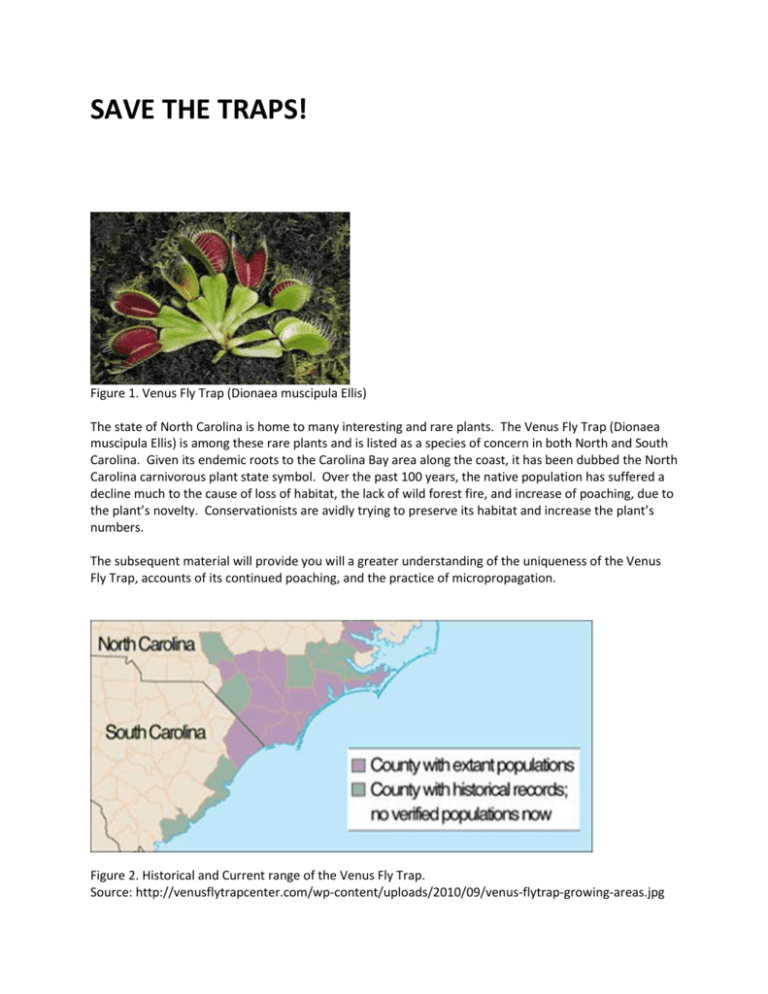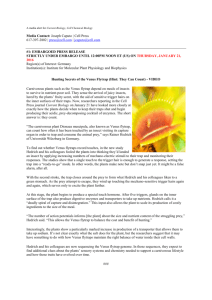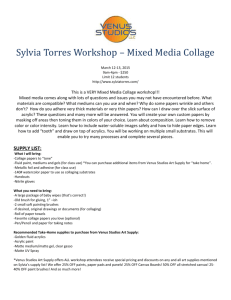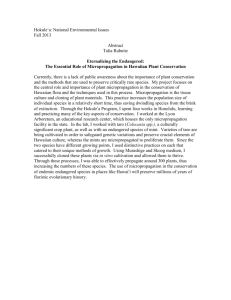SAVE THE TRAPS! Figure 1. Venus Fly Trap (Dionaea muscipula
advertisement

SAVE THE TRAPS! Figure 1. Venus Fly Trap (Dionaea muscipula Ellis) The state of North Carolina is home to many interesting and rare plants. The Venus Fly Trap (Dionaea muscipula Ellis) is among these rare plants and is listed as a species of concern in both North and South Carolina. Given its endemic roots to the Carolina Bay area along the coast, it has been dubbed the North Carolina carnivorous plant state symbol. Over the past 100 years, the native population has suffered a decline much to the cause of loss of habitat, the lack of wild forest fire, and increase of poaching, due to the plant’s novelty. Conservationists are avidly trying to preserve its habitat and increase the plant’s numbers. The subsequent material will provide you will a greater understanding of the uniqueness of the Venus Fly Trap, accounts of its continued poaching, and the practice of micropropagation. Figure 2. Historical and Current range of the Venus Fly Trap. Source: http://venusflytrapcenter.com/wp-content/uploads/2010/09/venus-flytrap-growing-areas.jpg Source: http://www.hcs.harvard.edu/~hsr/wp-content/uploads/Fall%202012/Feeding%20the%20Leafy%20Monster%20%20Tristan%20Wang.pdf The following is a news article exert from The Nature Conservancy. Find the full article at: http://www.nature.org/ourinitiatives/regions/northamerica/unitedstates/northcarolina/newsroom/venus-flytrap-poachers-charged.xml Three Charged with Venus Flytrap Poaching Plants replanted by Conservancy staff Replanting Venus flytraps TNC employees quickly replanted the poached flytraps How to contact the WRC to report suspicious activity Flytrap close up The inside of one of the state's most famous carnivorous plants Learn more about how flytraps work DURHAM, NC | January 24, 2012 Three Brunswick county residents were charged with poaching Venus flytraps from The Nature Conservancy’s Green Swamp Preserve in Brunswick County. The flytraps have been returned safely to their home in the swamp, and the Conservancy remains vigilant for the ever-present problem of poaching. “They’re stealing our natural heritage,” says Angie Carl, who works in the Conservancy’s Wilmington office. “This is a problem for everyone. Venus flytraps are only found in this tiny corner of the entire world. They’re depleting one of the only viable populations of flytraps remaining in the wild.” The three charged are: Kasey Gerald Whaley, Joyce Zarol Whaley and Elizabeth Ann Whaley. All are residents of Shallotte. They were charged with taking protected plants without the written consent of the landowner, which is a Class 2 misdemeanor. Their next court date is March 27. Carl says the poachers were caught Monday because of the combined efforts of several state agencies. Staff from the N.C. Division of Forest Resources notified Carl about suspicious activity at the preserve. She then contacted officers with the N.C. Wildlife Resources Commission who apprehended the poachers. “This is a heads-up. We hope that the many law-abiding people who know the Green Swamp and other preserves will keep an eye out for unusual activity and call the Wildlife Resources Commission,” Carl explained. Poaching can be reported to the Commission at 1-800662-7137. Two hundred flytraps were dug up Monday. Conservancy staff replanted the flytraps. You can help stop this illegal behavior by buying flytraps from reputable sources, which have cultivated them in greenhouses. If you see someone selling flytraps at a flea market, on the roadside or over the Internet, there is a good chance that they are stolen. Flytraps are easily reproduced legally. Southeastern Community College in Whiteville has a program that teaches students how to reproduce flytraps through cloning. Legal flytraps are available through a number of sources, including the North Carolina Botanical Garden in Chapel Hill. How are Venus Fly Traps cultivated and reproduced legally? Tissue Culture or Micropropagation www.flytrapcare.com Tissue culture, also known as micropropagation, is a propagation method used to produce plants under sterile conditions. This method uses plant explants (plant parts) or seeds that have been sterilized before being placed in containers with a growing medium (usually a gel) that has some nutrients added. This method allows plants to grow faster and one can multiply them rapidly. An infinite number of plants could be created from just one piece of tissue and in a brief period of time. Many types of seeds germinated in these conditions tend to grow very fast compared to being sowed in standard growing media outside of sterile, enclosed containers. Using plant tissue, it is possible to grow exact copies of the donor plant. This is extremely useful for plants that genetically have desirable traits because one can create many clones of a particular plant much faster than traditional propagation methods like cuttings, pullings or divisions. Four stages of plant tissue culture have been defined by a scientific pioneer in the field, Toshio Murashige, professor emeritus of the University of California at Riverside: Stage I. Establishment of an aseptic (sterile) culture. Stage II. The multiplication of propagules (a propagule is any part of a plant used to make or become new plants). Stage III. Preparation of propagules for successful transfer to soil (rooting and "hardening" (acclimating) outside of sterile conditions in regular growing media). Stage IV. Establishment in soil (or other appropriate growing medium). Darwin’s Theory of Natural Selection The observations made by Charles Darwin helped him formulate the theory of natural selection which he believed is the driving power of evolution. The theory of natural selection has many principles one of which is that every species has variations. The most beneficial variations are passed from one generation to the next. SAVE THE TRAPS! What is your argument? As conservationists join the fight to preserve the Venus Fly Trap, the question of how to best do this continues to arise. Many have suggested using micropropagated clones to remediate declining populations and reestablish colonies within its historical range. Would the use of micropropagated Venus Fly Trap clones be beneficial in conversation efforts? In the space below, write an argument in order to persuade another conservationist that your claim is valid and acceptable. Your Claim: Your Evidence: Your Justification of the Evidence: SAVE THE TRAPS! Rubric for Generating an Argument Aspect of the Argument The claim Point Value 0 1 The claim is sufficient The claim is accurate The evidence Includes data Includes an analysis of the data Includes and interpretation of the analysis The justification of the evidence Explains why the evidence is important or why it is relevant Links the evidence to an important concept or principle Language of science Appropriate use of scientific terms Used phrases that are consistent with the nature of science Mechanics The order and arrangement of the sentences enhances the development of the main idea (organization) The author used complete sentences, proper subject-verb agreement, and kept the tense constant (grammar) The author used appropriate spelling, punctuation, and capitalization (conventions) Total Score /12 Comments or Suggestions Identifying the six steps for scientific argumentation Place the following steps in order of completion. ______ The scientific question starts from an observed scenario that generates a scientific investigation. _____ The rebuttal is the discussion coming from the audience. It can counteract or refute the original question _____The initial statement is referred to as your assumption. It is used to describe the scenario. _____The explanation summarizes the claims and provides interpretation. _____ Evidence is extracted in the form of observations or measurements. _____The claim is an assertion or conclusion that answers your scientific question. It is also used to summarize the findings of your inquiry. SAVE THE TRAPS! Teacher Notes Purpose The purpose of this activity is to help students understand 1) micropropagation and how it can be used in conservation efforts of endangered plant species and 2) how micropropagation plants could affect the native, endangered population if introduced. This activity will ask students to draw upon Darwin’s theory of natural selection to understand that a population with diverse variations will have the greatest chance of survival over time. This activity will also help students construct explanations, argue from evidence and communicate information. This activity is also designed to give students and opportunity to learn how to construct scientific writing. The Content and Related Concepts The Venus Fly Trap (Dionaea muscipula Ellis) is endemic to southeastern North Carolina. It has been listed as a species of concern due to loss of habitat, wild fire suppression and poaching. Due to the carnivorous plant’s novelty to the public, it is being poached in high numbers. There are numerous accounts of poachers being caught by authorities. Many conservationists have been teaming up to figure out solutions to combat the Venus Fly Traps dwindling numbers. Micropropagation of plant tissue and seeds is a sterile and quick way of mass produce plant material. One Venus Fly Trap could produce as many as 10,000 cloned plants with in a year. Micropropagation could be a viable solution to remediate small populations and reestablish colonies in previous areas. Students will need to understand the principles of Charles Darwin’s Theory of Natural Selection. A population will contain diverse range of variations. The more variations a population has, the more likely the population will continue to thrive. Curriculum and Instructional Considerations This activity can be used in a Biology class. It is recommended to do this activity after introducing Darwin’s Theory of Natural Selection. If revisiting evolution or to refresh students on the concept of evolution, consider playing “Who Wants to Live a Million Years?” (http://science.discovery.com/games-and-interactives/charles-darwin-game.htm) This activity could be used as an assessment tool to gauge student’s understanding of the roles variations play in the evolution of a species. Following discussions after this activity could include aspects of the nature of science such as scientific knowledge can be subjective and is socially and culturally embedded. Recommendations for Implementing the Activity This activity will take 1-2 sessions of 90 minutes of instructional time to complete. Materials Student Handouts Argument Model Sequence of Instruction Day 1 5 minutes – Identify task and question 10 minutes – Read articles 20-30 minutes – Generate a tentative argument 15 minutes – Argumentation session Day 2 15 minutes – Reflective discussion 40 minutes – Production of a final written argument Assessment Students will formulate an argument to the research question in order to persuade another conservationist that their claim is valid and acceptable. Students will use their argument model in their handout to guide this process. The rubric provided in the student handouts can be used to assess the arguments crafted by each student at the end of the activity. Standards Addressed in This Activity Next Generation Science Standards HS-LS4-2. Construct an explanation based on evidence that the process of evolution primarily results from four factors: (1) the potential for a species to increase in number, (2) the heritable genetic variation of individuals in a species due to mutation and sexual reproduction, (3) competition for limited resources, and (4) the proliferation of those organisms that are better able to survive and reproduce in the environment. HS-LS4-4. Construct an explanation based on evidence for how natural selection leads to adaptation of populations HS-LS4-5. Evaluate the evidence supporting claims that changes in environmental conditions may result in: (1) increases in the number of individuals of some species, (2) the emergence of new species over time, and (3) the extinction of other species. HS-LS4-6. Create or revise a simulation to test a solution to mitigate adverse impacts of human activity on biodiversity. North Carolina Essential Standards Bio.3.3.3 Bio.3.4.2 Evaluate some of the ethical issues surrounding the use of DNA technology (including cloning, genetically modified organisms, stem cell research, and Human Genome Project). Explain how natural selection influences the changes in species over time. This activity can be used to address the following dimensions outline in A Framework for K-12 Science Education (NRC 2012): Scientific Practices Constructing Explanations and Designing Solutions Engaging in Argument from Evidence Obtaining, Evaluating, and Communicating Information Crosscutting Concepts Patterns Cause and Effect Connections to Nature of Science: Scientific Knowledge Assumes an Order and Consistency in Natural Systems Life Sciences Core Ideas Natural Selection Adaptions Biodiversity and Humans Engineering, Technology, and Applications of Science Core Ideas Developing Possible Solutions This activity can be used to address the following standards for literacy in science from the Common Core State Standards for English Language Arts and Literacy (NGA and CCSSO 2010): Writing Text types and purposes Production and distribution of writing Research to build and present knowledge Range of writing Speaking and Listening Comprehension and collaboration Presentation of knowledge and ideas References National Governors Association Center (NGA) for Best Practices, and Council of Chief State School Officers (CCSSO). 2010. Common core state standards for English language arts and literacy. Washington, DC: National Governors Association for Best Practices, Council of Chief State School. National Research Council (NRC). 2012. A framework for K-12 science education: Practices, crosscutting concepts, and core ideas. Washington, DC: National Academies Press. Science Channel. (n.d.). Charles darwin's game of survival: Science channel. Retrieved from http://science.discovery.com/games-and-interactives/charles-darwin-game.htm The Nature Conservancy. (24, 01 2012). Three charged with venus flytrap poaching. Retrieved from http://www.nature.org/ourinitiatives/regions/northamerica/unitedstates/northcarolina /newsroom/venus-flytrap-poachers-charged.xml Tissue culture or micropropagation. (n.d.). Retrieved from www.flytrapcare.com Wang, T. (2012, ). Feeding the leafy monster. website: http://www.hcs.harvard.edu/~hsr/wpcontent/uploads/Fall%202012/Feeding%20the%20Leafy%20Monster%20%20Tristan%20Wang.pdf







